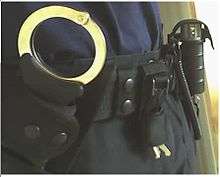Belt (clothing)

A belt is a flexible band or strap, typically made of leather or heavy cloth, and worn around the waist. A belt supports trousers or other articles of clothing. It is an item of accessory.
History
Belts have been documented as male clothing since the Bronze Age. Both genders have used them off and on, depending on the current fashion. In the western world, belts have been more common for men, with the exception of the early Middle Ages, late 17th century Mantua, and skirt/blouse combinations between 1900 and 1910. Art Nouveau belt buckles are now collectors' items.
In the latter half of the 19th century and until the First World War, the belt was a decorative as well as utilitarian part of military uniform, particularly among officers. In the armed forces of Prussia, Tsarist Russia, and other Eastern European nations, it was common for officers to wear extremely tight, wide belts around the waist, on the outside of the uniform, both to support a saber and for aesthetic reasons. These tightly cinched belts served to draw in the waist and give the wearer a trim physique, emphasizing wide shoulders and a pouting chest. Often the belt served only to emphasize the waist made small by a corset worn under the uniform, a practice which was common especially during the Crimean Wars and was often noted by soldiers from the Western Front. Political cartoonists of the day often portrayed the tight waist-cinching of soldiers to comedic effect, and some cartoons survive showing officers being corseted by their inferiors, a practice which surely was uncomfortable but was deemed to be necessary and imposing.
In modern times, men started wearing belts in the 1920s, as trouser waists fell to a lower line. Before the 1920s, belts served mostly a decorative purpose, and were associated with the military. Moreover, prior to that trousers did not even have belt loops. As sportswear, trousers with belt loops were already present in the 19th century.[1] Today it is common for men to wear a belt with their trousers.
In some countries, especially the United States, a father's belt can be associated with corporal punishment. As belts are constructed out of materials like leather that are both strong and light, a belt can be easily wielded to produce intense pain by using it as a whip to strike the buttocks of a misbehaving child. Moreover, belts are convenient disciplinary tools, as they are generally immediately available for use. The belt can symbolize fatherly authority and paternal responsibility for one's children's behavior and moral development.
Since the mid-1990s, the practice of sagging has been practised at times among young men and boys. This practice is sometimes incorrectly believed to have originated with prison gangs[2] and the prohibition of belts in prison (due to their use as weapons and devices for suicide).
Variants

- One specialized type of belt is the utility belt or Police duty belt, which includes pockets for carrying items that the wearer needs for prompt use and loops to hang larger items. Police officers, soldiers, and repair personnel are typical roles which use this kind of belt. Duty belts are generally wider than dress belts, and are stiffer to better provide for the carry of heavy items such as pistols. It is common military practice for such a belt to be a symbol of authority or to indicate that the wearer is on duty. Such belts are worn even if no equipment is carried on them. A notable fictional example is Batman's utility belt.
- The obi is traditionally part of a Japanese kimono.
- A common sight in fantasy and role playing characters is the excessive use of belts in all different sizes on the character's person. Usually they are used for securing clothing or armor, but others just have several belts around the arms, legs, neck, waist, hips, and across the breasts for decoration. Sometimes they are used in place of eye patches or to decorate weapons. This was also common in superhero costume design of the early 1990s.
- A studded belt is typically made of leather or similar materials, and is decorated with metal studs. Studded belts are often a part of punk/emo scene, skater, Goth and metal fashion, but are more common for teenage girls, usually worn with jeans and high heels, or knee-high heeled leather boots tucked into jeans.
- Instead of wearing a conventional belt, skateboarders often wear shoelaces in belt loops to hold their trousers up. This is done mostly for fashion, but it is also useful because belt buckles often dig into a skater's stomach when skating. Since shoelaces do not require belt buckles, this digging is avoided. Another reason this is done is to avoid the excessive pain belts can cause if a skateboarder should fall.
- They are also used in judo, karate and other martial arts, where different colors may indicate rank or skill.
- A breast belt is a belt worn by women that holds their breasts up, making them appear larger or more prominent underneath clothing. It is worn generally above or on the stomach but just beneath the breasts.
- The leg belt is another fashionable article of clothing which, as the name suggests, one wears upon the leg.
- The baldric is a variant that is worn over a shoulder and the chest. It was typically used to carry a weapon or another implement.
Miscellaneous
The Republica Fashion's Gucci 30 carat Diamond belt, studded with diamonds and a platinum buckle, has been advertised as the most expensive production belt ever produced.[3]
References
- ↑ See pictures File:NY Metropolitans.jpg or File:1868 Reds.jpg for instance.
- ↑ snopes.com: Sag Harbored
- ↑ Most expensive belt in the world? How about $249,000!
| Wikimedia Commons has media related to Belts. |